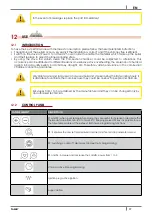
13
FAMILY
EN
Fig. 11 - Example 3
LEGEND
1
Insulating material
2
Inspection plug
3
Minimum safety distance = 0,5 mt
•
External chimney flue entirely made up of insulated stainless steel pipes, i.e. with double wall of minimum
Ø100/120 mm: all must be firmly attached to the wall. For chimney against wind effects please (see
).
•
Ducting system through T-unions which enables an easy cleaning without disassembling the pipes.
We recommend to check with your chimney flue manufacturer the safety distances which
must be respected and the type of insulating material. The aforesaid regulations are valid
also for holes made on the wall (EN 13501 - EN 13063 - EN 1856 - EN 1806 - EN 15827).
10
FUEL
10.1
FUEL
•
Use top-quality pellets because they have influence in the calorific value and in ash remains.
•
Pellets features are: dimension Ø6-7mm (D06 Class), maximum lenght 40 mm, calorific value 5kWh/kg, humidity
≤ 10%, ash remains ≤ 0,7%, they must be correctly pressed and not much mealy, without sizing agents, resins
and other additives (it is advisable to use pellets in compliance with the regulation EN14961-2 type ENplus-A1).
•
Not adequate pellets cause a bad combustion, a frequent burning pot obstruction and exhaust conduits
obstruction. Further it decreases the calorific value, soils the glass and increases consumptions and ash and
unburnt granules quantity.
Humid pellets cause a bad combustion and running, so please assure you that they are
stored in dry places and far at least one meter from the stove and/or any other source of
heat.
•
It is advisable to try different type of pellets available on the market and to choose that which gives the best
performance.
•
The use of bad quality pellets can damage the stove so that the warranty and manufacturer liability fall.
•
On all our product are used high-quality materials such as stainless-steel, steel, cast iron, etc... These materials,
before being sold on the market, are tested in laboratory, but despite this on the components which enable
the pellets flow (auger) there could exist minimum differences in the material used, in roughness and porosity,
which could generate usual variations in fuel transportation (pellets), causing a flame raising or drapping with
a possible switching off at lower powers.
•
Depending on the type of pellets it could be necessary a parameters adjustment, please contact an
Authorized Assistance Service.














































